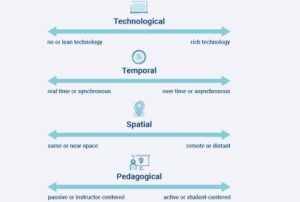Embedding digital pedagogy
Incorporating digital approaches to teaching and learning is an important aspect of course and programme design.
Perceptions about the University campus changed during the pandemic as we became reliant on the digital campus. The University of Edinburgh digital strategy acknowledges the key role the digital estate has had on teaching and learning. It outlines a vision for the digital and physical estates to ‘fuse seamlessly’. During course and programme design it is important to consider how we might integrate the digital and physical campuses when designing our courses and programmes. To help us do this, we need to explore various modes of learning and consider how they shape the teaching and learning experience.
Are students going to be on campus, learning in blended or hybrid modes, or be fully online students? The majority of courses we design incorporate some aspects of blended learning. The following model identifies the main components we need to consider when designing courses and programmes for blended learning. These are technological, temporal, spatial, and pedagogical.

Four-dialectical model of blended learning. Joosten et al, 2021. CC BY-NC-ND
Each of the components is depicted on a spectrum which highlights the complexities and choices we need to make when designing blended courses and programmes.
- Technological identifies a spectrum of technologies from lean (e.g., text-based or oral comms) to rich technologies (media, live meeting tools).
- Temporal identifies real time/synchronous learning through to asynchronous where students work independently over time.
- Spatial involves students being in the same physical space or learning elsewhere.
- Pedagogical which ranges from passive to active learning.
Blended learning offers opportunities for flexibility which can often lead to a more inclusive and equitable learning experience. This Teaching Matters blog post explores equality, equity, and social justice during hybrid learning. Embedding flexibility and choice into learning design is a key aspect of the Universal Design for Learning (UDL) framework, which is explored in the Universal Design section and embedded in the Accessible and Inclusive learning policy.
The complexities of digital pedagogy is reflected in the language we use to describe it and the same terminology can have different meanings. An example of this is the term hybrid which is often used interchangeably with blended (QAA, 2020). We’re also seeing the term post-digital being introduced, which describes human relationships with technologies (Jandrić et al, 2018).
When considering digital pedagogy don’t get too caught up in the language, as it will continue to evolve with technological advancements. We’ve already highlighted some models to help you consider digital pedagogy when designing your teaching, and the resources provided in this section will help you as you explore how you might embed digital pedagogy into courses and programmes you are designing.
Short courses
There are two relevant University of Edinburgh-designed MOOCs:
How to create an online course:
- Understanding your learners (topics include personas, diversity and inclusion).
- Active Learning (examples of active learning, designing course narrative).
- Making content engaging (chunking and interactivity, open content, accessibility, learning sequences).
- Digital Toolbox (choosing and justifying tools).
- Pre-production (why and when to use video, shot types, scripting and storyboarding, 3rd party content, preparing for filming).
- Production (audio, camera and equipment set up, recording a video and reflecting on experience).
- Post-production (editing software, an editing demo, accessibility: captioning and open licensing).
Making blended education work: This is a Future Learn MOOC that is aimed at those involved in leading the design and implementation of blended learning including course leaders. The course explores critical dimensions of blended learning, including institutional culture and leadership. The University of Edinburgh were partners in the development of this MOOC. The Intended Learning Outcomes are below (taken from the course introduction). By the end of the course, you'll be able to:
- Describe and critically discuss the conceptualisation of blended education.
- Assess and analyse the benefits and challenges of blended education.
- Demonstrate critical understanding of the relationship between beliefs and practice in blended learning and teaching.
- Apply key principles of blended learning for programme/course design.
- Evaluate the quality of blended education.
Benefits & Challenges of Blended Learning: This Teaching Matters blog post highlights some of the concepts discussed during the course.
Toolkits, guidance, and websites
- Learning Technology (website): An overview of the digital technology tools and support from The University of Edinburgh.
- Beyond blended: rethinking curriculum and learning design (Jisc toolkit): A toolkit to help curriculum teams consider the pedagogic differences between modes of learning.
- Exploring the digital pedagogy toolkit (Jisc toolkit): A toolkit to help educators make informed choices when embedding digital into the curriculum.


Comments are closed
Comments to this thread have been closed by the post author or by an administrator.